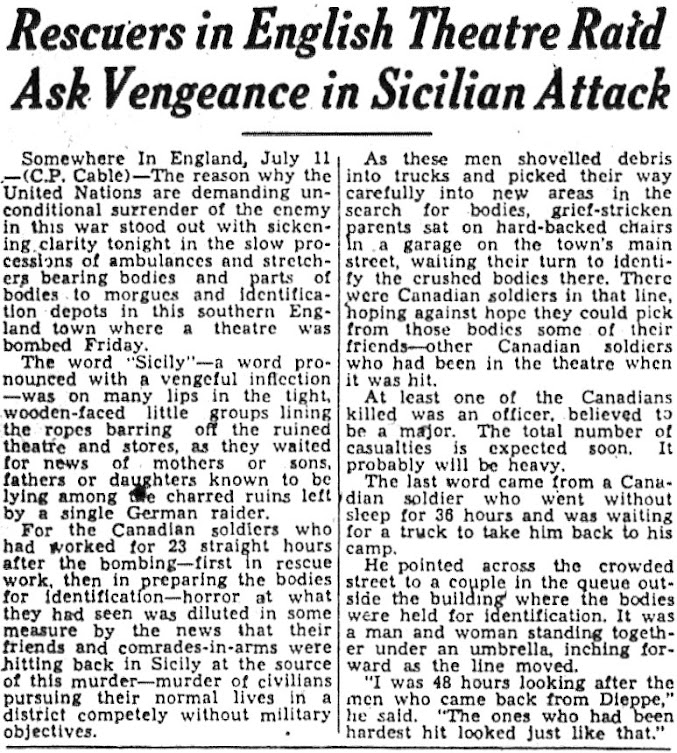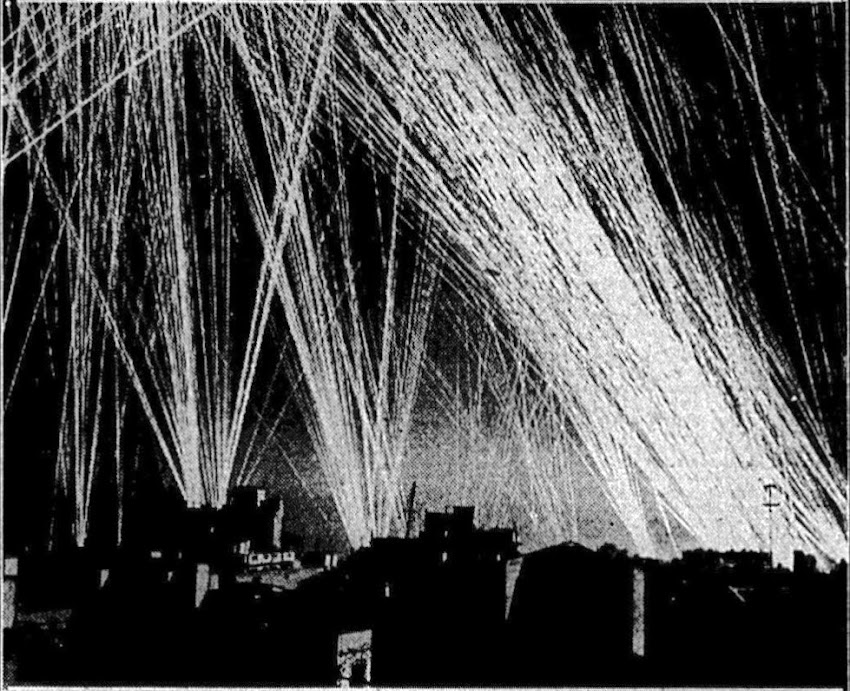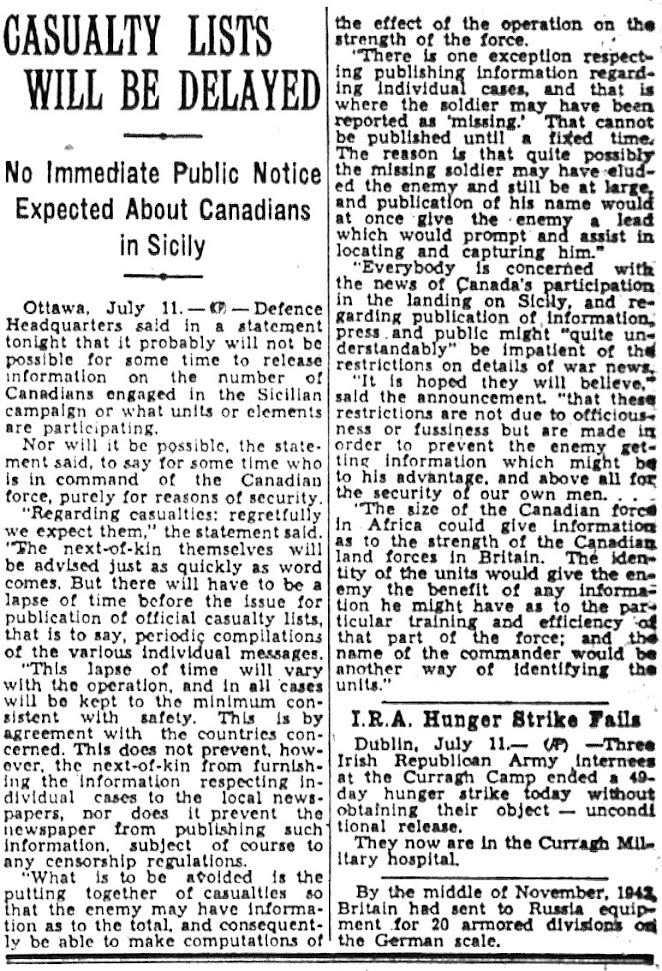D-Day Sicily, Operation Husky Begins, July 10, 1943
More 'Gazette' News Clippings from July 12
Fortunately, it did not take long for beachheads to be formed and for
all materials of war to be stockpiled for Allied use. Photo as found in
"They Left the Back Door Open" by Lionel S. B. Shapiro, pg. 15
Photo Credit - Lieut. Dwight E. (Joe) Dolan, No. 21538, Album 61 of 110 (LAC)
As mentioned in the previous post, not all news stories concerning the first day of the invasion of Sicily made it back to Montreal in time for Gazette staff to insert them into the D-Day edition (a Saturday). Just as well, readers surely don't want their favourite columnists or war correspondents to scrimp on details just to get their story flashing back to Canada on the underwater cable.
After the Sunday break, Monday can sometimes be a slow news day. But not today! Not after D-Day + 2:
Members of the Royal Canadian Navy Volunteer Reserve and Combined Ops (a
British org.), "Represent Cross Section of Dominion from Maritimes to B.C."*
[*about 1,000 Canadians volunteered for Combined Operations during WWII, beginning with the first draft in November - December, 1941 (including my father D. Harrison, Ontario, listed on hammock above), and were soon learning how to handle landing crafts in S. England (Hayling Island) and NW Scotland (Inveraray). Their first action was the Dieppe raid, soon followed by the invasion of N. Africa, Sicily, Italy and Normandy, France. The hammock was given to Sub. Lt. Davie Rodgers by Leading Stoker W. Katana on their way to Operation Husky (invasion of Sicily). It was much later donated to the Navy Museum in Esquimalt, B.C. Ross Munro reported on Canadian troops in SE Sicily while the 55th, 61st, 80th (marked on hammock) and 81st Flotilla of Canadian Landing Crafts served on the eastern shores of Sicily, south of Syracuse.]
Map from Combined Operations, by Londoner Clayton Marks, pg. 76
Gazette article continues:
From the editorial page, July 12, 1943:
Also from the editorial page:
Please click here to read an excerpt (Part 6 of 8) from a sailor's memoirs concerning the Dieppe Raid, as he recalls delivering Canadian troops in a landing craft to the stony, murderous shores that lay ahead. The Dieppe Raid: August 19, 1942 - Part 6:
The Gazette editorial continues:
Yes, I do shine the spotlight on the Canadian navy, especially those in RCNVR. To balance things out, here are a few words about the Italian navy:
[A few words and photos about Italian 'human torpedos' will be shared in a later post.]
Memories of Dieppe return to a Canadian soldier after a very damaging attack:
About one year later, a writer brings up part of that phrase in his remarks re the "spectacular landings of Allied forces on the shores of Sicily":
Everyone will have different opinions related to the "Best War Photos" especially since 1000s of better quality photographs related to WWII are now easily at our disposal. Imperial War Museum alone is reported to have over 11,000,000 in their own collection! And if I can find the originals re to the ones below, I will do so:
Here is one example of the original:
the N. African coast to take part in Operation Torch. Photo Source - CFR.org
And, "close but no cigar":
Convoy en route for Algiers. © Imperial War Museum A 12737
Photo by Hampton, J A (Lt) Royal Navy official photographer
Heading with above photo: NORTH AFRICAN OPERATIONS. BRITAIN'S ROYAL NAVY HAD A MAJOR ROLE IN THE WORLD'S GREATEST COMBINED OPERATION WHEN THE 500 SHIP CONVOY SAFELY TRANSPORTED ALLIED TROOPS TO FRENCH NORTH AFRICA, WHERE SIMULTANEOUS LANDINGS WERE MADE AT STRATEGIC POINTS. NOVEMBER 1942.
Another near miss:
Many factors, including technological advances and rapid ship production,
enabled the Allies to win the Battle of the Atlantic, but the most important
was adoption of the convoy system. U.S. Naval Institute Photo Archive
century US Military History print features ack-ack fire being used by the
Allied Forces to counter a Luftwaffe air raid by the Nazison Algiers,
French Algeria in 1943. Photo - fineartamerica.com
"Best War Photos" continues:
I may not have found the exact same photo but I'm confident it is "same time, same place":
Allied troops boarding assault craft in a North African port, apparently Bizerte,
Tunisia, en route to Sicily for Operation HUSKY in early July 1943.
Photo Credit - The Liberation Trilogy by Rick Atkinson*
*Note to Readers: The Liberation Trilogy is one of the best sets of books I've read about World War II. About ten years ago I found Volume 1 (An Army At Dawn) at Chapters Book Store and soon had all three volumes. I said a few words about Volume 1 here.
And now, back to news clippings from The Gazette:
The significance of Canadian war correspondent Ross Munro's "first story" cannot be understated. Whoever was sitting at "the Canadian Press clable (sic - cable) desk in New York" must have been waiting with bated breath!
It seems that Russian leaders are not as excited about Operation Husky as everyone else!
I tip my hat to Ross Munro. Not only first in line but very thorough. Names of some officers listed below will perhaps lead to more searches and research on my part, e.g., "Sub-Lt. Andrew Clark of Hamilton, Ont." who was "at Oran during the original North African landings last autumn, taking American shock troops into the beaches." As was my father and several other members of RCNVR and Combined Operations (COps), just east of Oran, at Arzeu beginning on November 8, 1942.
One of the other war correspondents mentioned above is Lionel Shapiro, and many of his articles will be a part of this series re 'Three Months in The Med.' Some other officers listed are from my home city, London Ontario. So, a bit more searching is almost certain.
Below is an excerpt from an online video (YouTube) related to the invasion of Italy (Operation Husky - 1943 by British Pathe). I do not know which beach is being shown, but it looks like an easy time.
Operation Husky - Invasion of Sicily, 1943
My father did not enjoy such an easy time at George Sector or Beach, Sicily (modern day Fontane Bianche, south of Syracuse), but he did in the previous year's invasion of North Africa. A couple of photos in which he appears are shared below:
Troops and ammunition for light guns being brought ashore from a landing craft
assault (ramped) (LCA 428) on Arzeu beach, Algeria, North Africa, whilst another
LCA (287) approaches the beach, during Operation 'Torch', Nov. 1942. IWM
The Canadian sailor (centre) is Doug Harrison, Norwich, Ont. RCNVR/COps
Please link to Three Months in the Mediterranean, 1943 (5)
Unattributed Photos GH


































No comments:
Post a Comment